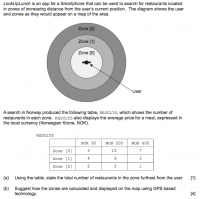 What are we going to learn today?[edit] What are we going to learn today?[edit]
Hello Class!
Computational thinking today!!
- We will take a 3 to 5 minute break to get grounded
- We will learn about GPS
We will then carefully read an IB test question and answer the questions. The questions are used from the IB and should not be reproduced with their consent.[1]

When you are done with the questions on the image, please consider the next part:
Another Smartphone app that is linked to LookUpLunch collects customers’ reviews for restaurants.
- A review consists of whether a customer likes the restaurant, and a rating of cheap (C), medium (M) or expensive (E). The app combines all of the reviews to produce a single letter rating (C, M or E) and a total number of likes for the restaurant.
- As part of the internal representation of the app, the collection LIKES is used. Some of the data items contained in LIKES are shown below. Each individual data item is separated by a comma.
0,26,TomHus,M,1,14,GladLaks,E,2,1,MerPoteter,C,1,15,Linie,E,0,2,Mezze,M...
The restaurant GladLaks, underlined as an example, is located within zone [1]. Based on the
reviews, this restaurant has 14 likes and is expensive.
- (c) Construct an algorithm that outputs the name of the restaurant with the most likes in zone [1]. [5]
- (d) By making use of binary trees and the collection LIKES, explain how a list could be produced that shows the restaurants in order of zone and then, within each zone, in order of popularity. [3]
Individual restaurants are able to use this app to see reviews from their customers.
- (e) Describe one disadvantage of the use of feedback from social networking in relation to business. [2]
|
 What is our homework?[edit] What is our homework?[edit]
Please come to class with the questions answered from todays lesson.
|
 How am I being assessed today?[edit] How am I being assessed today?[edit]
I will assess you formatively today, and make a professional judgement to what extent you understand our learning material. I will use observation, your written work, answers to questions, and contribution to class discussions as data to make my decisions. I normally record my observations in a "evidence of learning" spreadsheet, which I will happily share with you privately if you so wish. I usually need a day or two notice.
|
